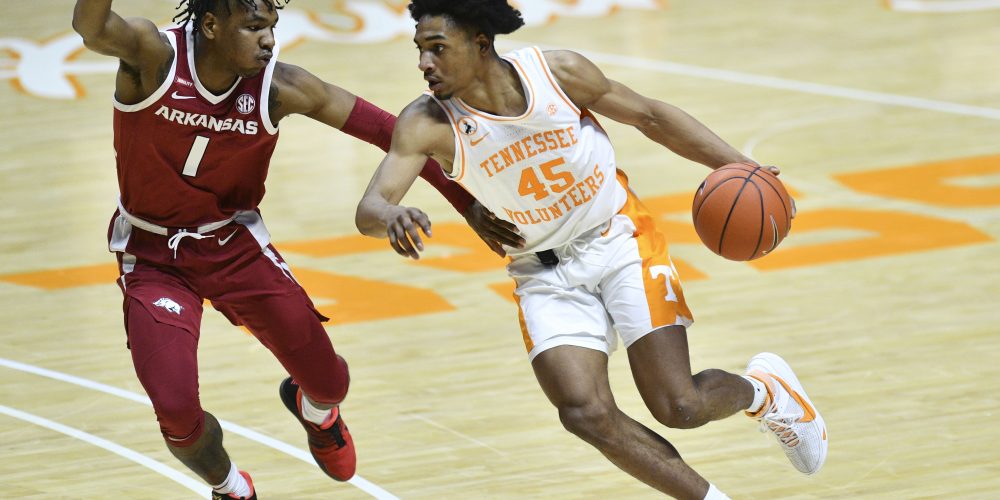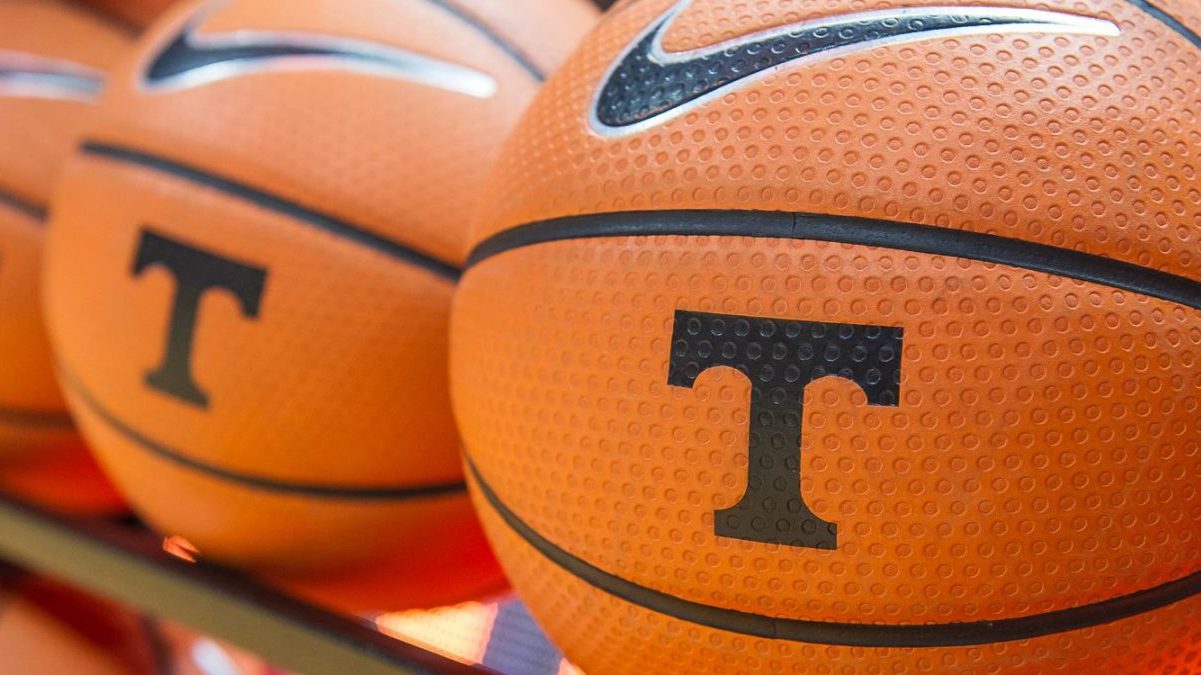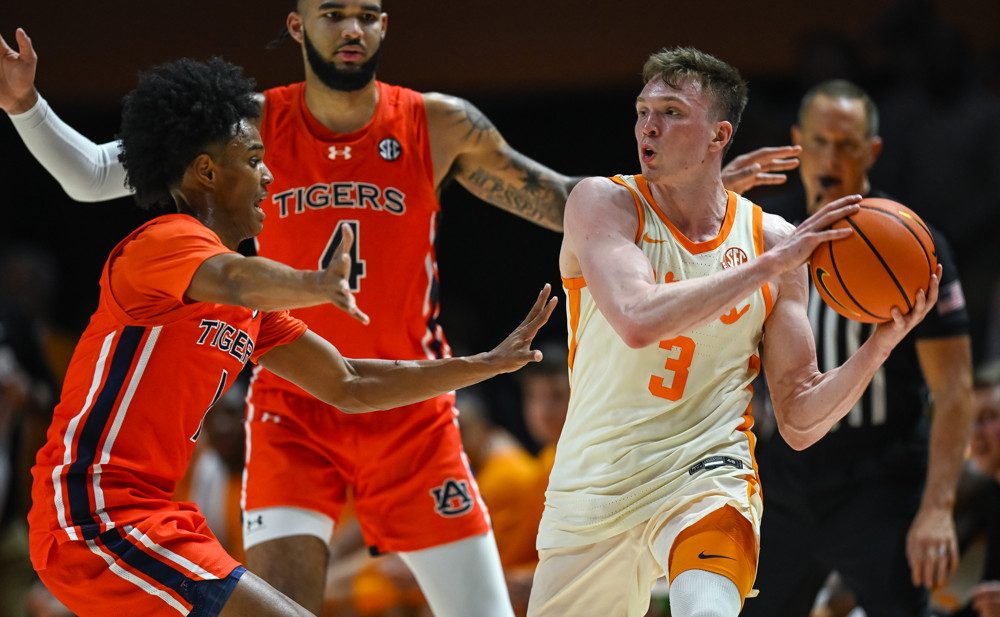Ten games in, we’d normally be 33% of the way through the regular season. But depending on whether Tennessee’s game with South Carolina gets rescheduled, we’re more like 40-42% of the way home this year. Either way, we’ve got enough data to draw a couple of meaningful conclusions about this team.
Their defense still sets them apart: 87.1 in KenPom’s defensive efficiency ratings is second nationally, and still the best for any Tennessee team ever. I still think the offense played better than it felt at Texas A&M, in part because they got a lot of action late in the shot clock: “This possession isn’t going anywhere, wait no here’s a bucket…”. On Sunday evening the Vols are 27th in KenPom’s offensive ratings, flirting with that dual Top 20 set every national champion has.
But the most striking thing about the offense continues to be how truly balanced it is.
Through these first ten games, Tennessee’s top seven scorers all average between 8-12 points per game. It makes the Vols harder to scout, harder to defend. Five of those seven have led the team in scoring already, but Santiago Vescovi’s 23 on Saturday are still the team’s season high.
And we really haven’t seen anything like that on a tournament team at Tennessee.
This year should/will make 10 NCAA Tournament teams from Tennessee in the last 16 years. The other nine had either four or five players each account for at least 10% of Tennessee’s total points (it jumps up to six players in 2006 and 2009 if you round up from 9.5%+).
But these Vols currently feature seven players accounting for at least 10% of Tennessee’s points:
| Bailey | 16.1% |
| Fulkerson | 15.1% |
| Vescovi | 13.4% |
| Springer | 13.0% |
| Johnson | 11.1% |
| James | 10.8% |
| Pons | 10.2% |
Offensively, Tennessee’s best teams have leaned either to the one-two punch, or far more balance:
One-Two Punch
| Year | 1st Scorer | % of Pts | 2nd Scorer | % of Pts | Top 2 |
| 2007 | Lofton | 26.1% | J. Smith | 19.1% | 45.2% |
| 2011 | Hopson | 24.1% | Harris | 21.7% | 45.8% |
| 2014 | McRae | 26.2% | Stokes | 21.2% | 47.4% |
In each of these cases, Tennessee’s top two scorers nearly outdid the rest of the team by themselves. Doing it this way can make your ceiling heavily reliant on what the third guy can give you: see Josh Richardon’s late emergence in Tennessee’s 2014 run. The 2007 Vols were guard dominant, still playing Dane Bradshaw post minutes while Ramar Smith was the team’s third leading scorer. And in 2011, there really wasn’t much happening behind Hopson and Harris, and little fluid offense overall beyond those two getting their own shots: Cameron Tatum was the third-leading scorer at 12.5% of the team’s points, the lowest for any third scorer on these tournament teams.
You can find the more balanced groups simply by looking at how much each team’s leading scorer contributed:
Balance
| Year | Leading Scorer | % of Total Points |
| 2014 | McRae | 26.2% |
| 2007 | Lofton | 26.1% |
| 2011 | Hopson | 24.1% |
| 2019 | Williams | 22.8% |
| 2009 | T. Smith | 22.2% |
| 2006 | Lofton | 21.2% |
| 2018 | Williams | 20.5% |
| 2010 | Chism | 19.2% |
| 2008 | Lofton | 18.7% |
| 2021 | Bailey | 16.1% |
In 2008, Tyler Smith’s arrival (and Chris Lofton’s health) made Tennessee far more diverse offensively, with great results. Tyler Smith also skews the 2010 math somewhat after being dismissed in early January, but Chism, Hopson, Prince, and Maze all ended up scoring between 14-19% of that team’s points overall, a strong sense of balance amongst that group.
Tennessee’s best offensive team walked the line between both: two years ago, Grant Williams had 22.8% of Tennessee’s points, Admiral Schofield 20%. But it was Jordan Bone’s offensive maturity – going from 9.8% of Tennessee’s points in 2018 to 16.4% in 2019, the third-leading scorer – that made a huge difference, while Lamonte Turner and Jordan Bowden continued to do their thing.
At the 40% mark, we shouldn’t expect these Vols to have a breakout offensive superstar. But I’m not sure we fully know what to expect beyond that, simply because we’ve never seen a Tennessee team rely on so many guys to get it done. That means one of the biggest unanswered questions is, “Who gets it done in crunch time?” Without Jaden Springer against Alabama and with John Fulkerson off the floor, Tennessee struggled. The late-game answer against Cincinnati and Arkansas was getting to the free throw line, with John Fulkerson a key component.
KenPom projects the Vols to play four one-possession games left on their schedule (at Florida, Kansas, at Kentucky, at LSU). The ebb and flow of a season suggests we’re going to see more than that in these last 14-15 games. Keep an eye on the crunch-time lineups.
The lead story should continue to be Tennessee’s defense. But the extraordinary, “It’s not about me,” balance of Tennessee’s offense is, so far, equally unheard of around here.




I’m also curious to see how depth/lineup usage plays out going forward.
Barnes has tightened the rotation such that those 7 guys you listed are basically getting all the minutes. Maybe there are games where Anosike or Nkamhoua can get more run, but do guys wear down playing such a heavy load?
We’ll see.
The battle between playing those seven guys and always yanking players with two first half fouls is a no-win situation. Can’t complain about Vescovi playing 36 minutes at A&M if he’s going to hit six threes, but yeah, this ain’t the year to be wearing guys down. I’m still surprised Davonte Gaines can’t get on the floor 4-8 minutes a night.